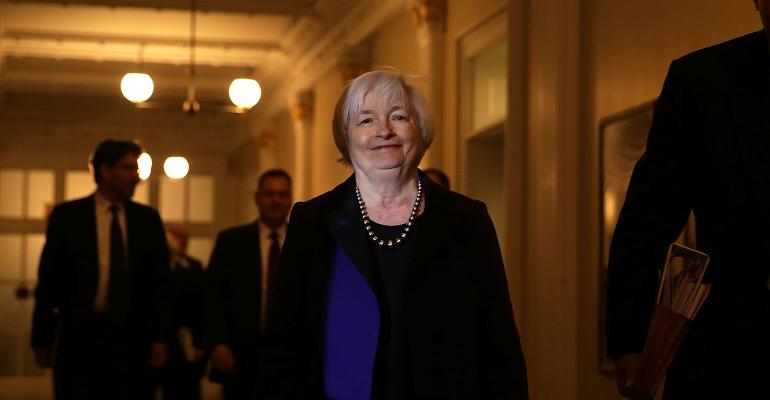By Matthew Boesler and Steve Matthews
(Bloomberg) --Federal Reserve leaders convene in Washington this week to discuss interest rates for the first time since the U.S. presidential election sent long-term bond yields and equity markets soaring on bets the new administration will stimulate growth.
While a quarter-point rate hike on Wednesday to a range of 0.5 percent to 0.75 percent is practically a foregone conclusion, investors will be keen to see how policy makers change their 2017 forecasts and what Fed Chair Janet Yellen has to tell journalists. She is scheduled to give a press conference 30 minutes after the 2 p.m. release of a post-meeting statement and new projections. Here’s what to watch for:
The so-called “dot plot” graphic, which contains rate forecasts of each of the 17 officials on the policy-setting Federal Open Market Committee, will give an early glimpse of their thinking about next steps. When the dots were last updated in September, the median projection -- shared by nine of the 17 central bankers -- called for two rate increases next year.
That’s a far cry from December 2015, when the median FOMC forecast was for four hikes this year and another four next. They cut those projections throughout 2016 amid financial-market turmoil, concerns about global growth and low inflation expectations.
It’s possible estimates will change direction and start rising again, said Roberto Perli, a former Fed economist who is now a partner at Cornerstone Macro LLC in Washington. He said only two of the nine FOMC members currently in agreement need to raise their forecasts for the median to show three hikes in 2017. Still, it may be too soon for that shift to occur, considering officials are uncertain about the shape and impact of President-elect Donald Trump’s policies.
“What seems likely is that the slide down in the dots that has been going on for quite a while should come to an end,” Perli said.
Upbeat Tone
The Fed’s statement will probably strike a slightly more upbeat tone on the state of the economy than previous communiques, especially after a Labor Department report this month showed the unemployment rate dropping to a nine-year low of 4.6 percent. Other economic indicators published in December, including consumer and business sentiment, point to an uptick in growth.
While central bankers may not be ready to change their forecasts for gross domestic product just yet, they could cut their estimates of the natural rate of unemployment that won’t trigger more inflation. FOMC participants put the natural rate at 4.9 percent last year before reducing it in March to 4.8 percent, which is still above than the latest reading.
“Their assessment of the unemployment rate -- whether they believe the recent drop was a statistical blip -- that has important implications for policy, so the way they phrase that will be important,” said Luke Tilley, the Wilmington, Delaware-based chief economist at Wilmington Trust Corp.
The big question facing Yellen will probably be how the committee views the impact of Trump’s plan for the economy, which entails as much as $1 trillion in infrastructure spending, tax cuts and deregulation. Reporters are likely to press her on the matter during the press conference, especially after New York Fed President William Dudley said last week that expansive fiscal policy could prompt a faster pace of monetary tightening.
“This year we have the promise of fiscal stimulus -- something that the Federal Reserve has been clamoring for,” said Anthony Chan, chief economist at JPMorgan Chase & Co.’s private wealth management unit in New York. “With an economy that is running hot -- granted, the Fed chair has talked about letting the economy run a little hotter -- if that continues, then you are going to see the Federal Reserve having to do a little bit more” hiking than they may have thought, he said.
--With assistance from Christopher Condon. To contact the reporters on this story: Matthew Boesler in New York at mboesler1@bloomberg.net ;Steve Matthews in Atlanta at smatthews@bloomberg.net To contact the editors responsible for this story: Brendan Murray at brmurray@bloomberg.net Randall Woods





